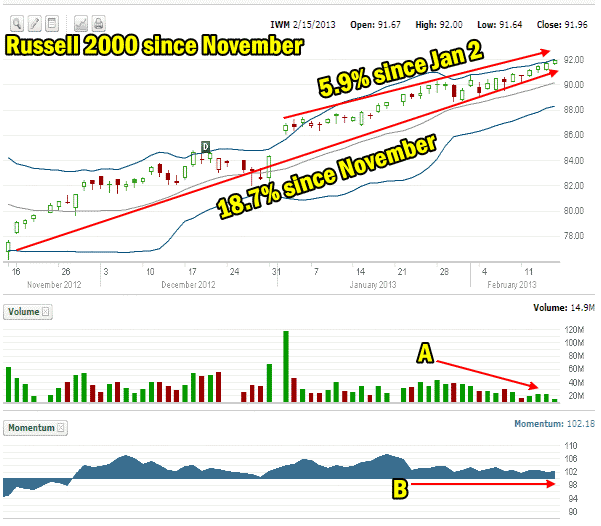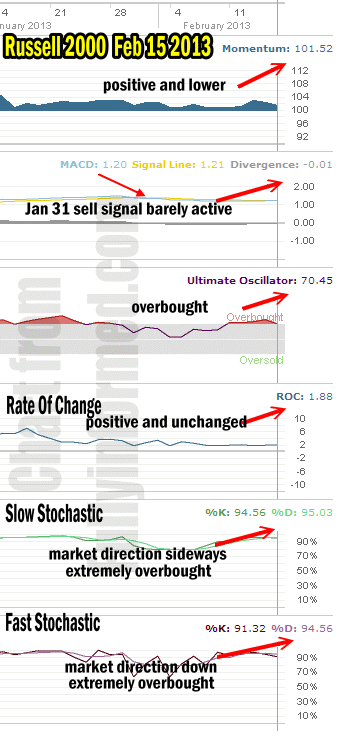In my intraday market direction comments on Friday Feb 15 2013 I commented how the Russell 2000 might be worth following while the S&P 500 is stuck in a sideways market direction. Often when the major indexes are having a tough time giving clear signals I turn to the Russell 2000 as it represents a good cross section of small cap stocks and the signals it gives can be compared to the S&P 500 for a possible confirmation of market direction.
Market Direction Russell 2000 for Friday Feb 15 2013
The Russell 2000 ETF has the trading symbol of IWM. On Friday it closed up just 0.03 at $91.74. As explained on Friday in the intraday market direction comments, IWM has had a terrific return so far this year. It is up 5.9% as on January 2 and up a stellar 18.7% since the markets bottomed on November 16 2012. I explained in my intraday market direction comments that in the Russell 2000 daily chart below you can see that volume is declining, never a good sign that the ongoing rally will continue (marked as A) but momentum (marked as B) is steady which is a good sign of strength.

Market Direction and Russell 2000 ETF since November 2012
Market Direction Technical Indicators Russell 2000
Let’s use the same market direction technical indicators that I use for the S&P 500 and apply them to the Russell 2000 as of Friday Feb 15 2013 and see if we can get a clearer picture of market direction.

Market Direction Technical Indicators Russell 2000 ETF
For Momentum I am using the 10 period. Momentum is positive and like the S&P 500, it is falling. It is though far more positive than the S&P 500 momentum.
For MACD Histogram I am using the Fast Points set at 13, Slow Points at 26 and Smoothing at 9. MACD (Moving Averages Convergence / Divergence) issued a sell signal on the Russell 2000 ETF on Jan 31 when the ETF was at $89.58. Unlike the S&P 500 the Russell 2000 sell signal was weak and has remained weak ever since. On Friday the sell signal although active was only negative 01 which is more flat than negative. Since the sell signal was issued, the Russell 2000 ETF is up 2.41%.
The Ultimate Oscillator settings are Period 1 is 5, Period 2 is 10, Period 3 is 15, Factor 1 is 4, Factor 2 is 2 and Factor 3 is 1. These are not the default settings but are the settings I use with the S&P 500 chart set for 1 to 3 months.
The Ultimate Oscillator is extremely overbought.
Rate Of Change is set for a 21 period. Rate Of Change is still positive and has been almost unchanged for 7 trading days.
For the Slow Stochastic I use the K period of 14 and D period of 3. The Slow Stochastic is overbought to the extreme and with both K% and D% readings so close, it is truly more sideways than down or up.
For the Fast Stochastic I use the K period of 20 and D period of 5. These are not default settings but settings I set for the 1 to 3 month S&P 500 chart when it is set for daily. The Fast Stochastic is also extremely overbought but it is signaling a definite downtrend in the market direction of the Russell 2000.
Market Direction Outlook For Feb 19 2013 for the Russell 2000
The market direction outlook for the Russell 2000 is almost the same as the S&P 500. There is underlying strength just like the S&P 500 and the signals being generated are also primarily cautionary in tone. This is typical of a bull market in a rally mode as it nears the end of a rally or when it is consolidating. The question posed by the two market direction outlooks is whether this is a consolidation or the last gasp of the rally. The MACD sell signal was very weak on the Russell 2000 since Jan 31 but because the move higher since then was a grind not a rapid move, the market direction technical indicators are having the same problem as they did with the S&P 500.
Even with the Russell 2000 then, the market direction indicators are advising investors that caution is advised at this stage of the rally. That does not mean don’t stay invested but it means to stay careful. When Put Selling, stay out of the money and sell smaller contract sizes. When buying stock, take smaller positions and be prepared to sell to close positions for even slim profits at the first sign of weakness. Don’t hold positions too long and consider taking profits all the time. Remember that when you take a profit, even if you are wrong and the move turns back higher, you have captured a profit and released your capital for further investments. There is never anything wrong with taking profits in an overbought market.
Internal Market Direction Links
Profiting From Understanding Market Direction (Articles Index)
Understanding Short-Term Signals
Market Direction Candlestick Daily View (Members only)
Market Direction Portfolio Ongoing Trades (Members only)
Market Direction External Links
